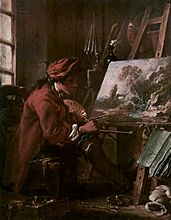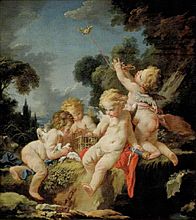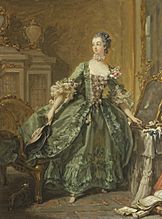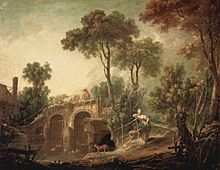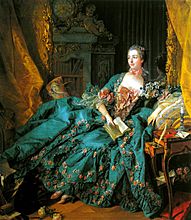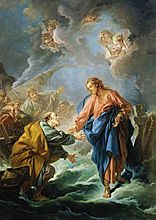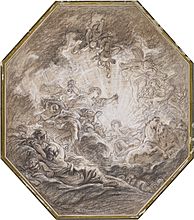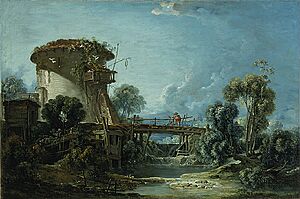François Boucher facts for kids
Quick facts for kids
François Boucher
|
|
|---|---|
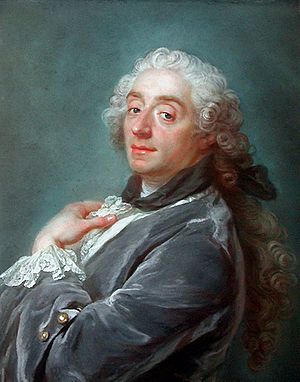
Portrait of François Boucher by Gustaf Lundberg (1741)
|
|
| Born | 29 September 1703 Paris, Kingdom of France
|
| Died | 30 May 1770 (aged 66) Paris, Kingdom of France
|
| Nationality | French |
| Known for | Painting |
| Movement | Rococo |
| Signature | |
 |
|
François Boucher (born September 29, 1703 – died May 30, 1770) was a famous French painter, draughtsman, and etcher. He worked in the Rococo style, which was popular in the 1700s.
Boucher is known for his beautiful and often playful paintings. These often showed scenes from old myths, decorative designs, and peaceful countryside views with shepherds and shepherdesses. He was one of the most celebrated artists of his time.
Contents
Life of a Famous Painter
François Boucher was born in Paris. His father, Nicolas Boucher, was also a painter and taught young François his first art lessons. When François was seventeen, another famous painter, François Lemoyne, was very impressed by his work.
Lemoyne took Boucher on as his student. But after only three months, Boucher went to work for an engraver named Jean-François Cars. Engraving is a way of making prints from a design carved into a surface.
In 1720, Boucher won the important Grand Prix de Rome for painting. This prize usually meant a chance to study art in Italy. However, due to money problems at the Royal Academy of Painting and Sculpture, he couldn't go for five years.
He finally went to Italy and returned to France. In 1731, he was accepted into the re-established Royal Academy. His special "reception piece" painting for this was Rinaldo and Armida in 1734.
Boucher married Marie-Jeanne Buzeau in 1733, and they had three children. His career really took off after 1734. He became a Professor, then the Rector (head) of the Academy. He also became an inspector at the Gobelins Manufactory, which made famous tapestries. Finally, in 1765, he became the "First Painter of the King."
Boucher passed away in Paris on May 30, 1770. His name, along with his important supporter Madame de Pompadour, became closely linked with the French Rococo art style. People even said he "represented the taste of a century."
Boucher once famously said that nature was "too green and badly lit." This shows his preference for artistic scenes rather than perfectly realistic ones.
Boucher also taught other artists. He taught Jacques Guay, who carved designs into gemstones. He also mentored Martin Ferdinand Quadal and the famous neoclassical painter Jacques-Louis David. Boucher even made drawings of Guay's work, which Madame de Pompadour had engraved and shared with her friends.
Boucher's Paintings
Boucher found inspiration from artists like Peter Paul Rubens and Antoine Watteau. His early paintings often showed peaceful and beautiful nature scenes with a lot of energy.
For example, his paintings The Enjoyable Lesson (1748) and An Autumn Pastoral (1749) show playful shepherds and shepherdesses in a forest. These characters were based on a play by Boucher's friend, Charles-Simon Favart. Later, these characters even inspired small statues made by the Sèvres Porcelain Manufactory.
Madame de Pompadour, who was King Louis XV's mistress, loved Boucher's art. She is often called the "godmother of Rococo" because she supported this style so much. Boucher's portraits of her were very important for how she presented herself to the world.
One example is his 'Sketch for a Portrait of Madame de Pompadour' (around 1750). In this sketch, she holds her hat in one hand and a pearl bracelet with a tiny portrait of the king in the other. This showed her important connection to the king.
Boucher's painting The Breakfast (1739) shows a family scene. It proves he was also great at painting everyday life. He often used his own wife and children as models for these cozy family pictures. These are very different from his Odalisque portraits, which showed women in a more exotic style.
Later in his career, Boucher's art faced some criticism, especially from the writer Diderot. However, he remained very popular with wealthy art collectors.
Designs for Theater and Tapestries
Besides his paintings, Boucher also designed costumes and sets for the theater. The lively stories in the comic operas by his friend Charles Simon Favart were very similar to the style of his paintings.
Boucher also designed tapestries. For the Beauvais tapestry workshops, he created a series called Fêtes italiennes ("Italian festivals") in 1736. These were very popular and were woven many times over the years. In 1737, he designed a series based on the story of Cupid and Psyche.
Over twenty years, Boucher created designs for six different tapestry series for Beauvais. He also made designs for royal parties and for the opera. He designed for royal palaces like Versailles, Fontainebleau, and Choisy.
His designs became very famous. Many prints were made from his work, and his designs even appeared on porcelain and biscuit-ware from the Vincennes and Sèvres factories. Boucher stopped working with Beauvais in 1755 but continued with the Gobelins until 1765.
Drawings and Prints
Boucher was a very talented and busy artist who made many drawings. His drawings were used in different ways. Some were early studies for his paintings, and others were designs for printmakers. But many were also finished artworks that collectors loved to buy.
Boucher usually started by planning the overall design of his large paintings. Then, he would make chalk drawings for individual figures or groups of people. He also used oil and gouache (a type of watercolor) sketches when preparing for big projects.
Over time, he made more and more sketches as independent artworks to sell. For example, the Adoration of the Shepherds (at the Metropolitan Museum of Art) is a free and painterly sketch in gouache. It was once thought to be a study for Madame de Pompadour's private altarpiece. However, experts now believe it was made much later as its own artwork. In his later years, Boucher often used brown chalk.
Boucher was also a skilled engraver and etcher. He created about 180 original copper plates for prints. He made many etchings based on the works of Watteau. This helped spread the popularity of reproductions of drawings. When his own drawings started selling well, 266 of them were etched by Gilles Demarteau. These prints were often made with red ink, so they looked like red chalk drawings. People could frame them and hang them in the small spaces on the decorated walls of fancy homes.
Boucher's most unique ideas were decorative. He helped create the popular style called chinoiserie, which used Chinese-inspired designs. He even etched 12 "Chinese Figures" by Watteau.
Gallery
-
Self-portrait in the Studio, 1720, Louvre
-
Putti with Birds, around 1730–1733, Honolulu Museum of Art
-
In this sketch, Boucher shows Madame de Pompadour before she goes out, around 1750, Waddesdon Manor
-
The Bridge, 1751, Louvre
-
Madame de Pompadour, 1756, Neue Pinakothek
-
Saint Peter Attempting to Walk on Water, 1766, Cathédrale Saint-Louis, Versailles
-
Aurora Heralding the Arrival of the Morning Sun, around 1765, National Gallery of Art
Some Works by François Boucher
Here is a list of some of François Boucher's artworks:
- Death of Meleager (around 1727), Los Angeles County Museum of Art
- Project for a Cartouche (around 1727), Los Angeles County Museum of Art
- Imaginary Landscape with the Palatine Hill from Campo Vaccino (1734), Metropolitan Museum of Art
- Monument to Mignard (around 1735), Los Angeles County Museum of Art
- Venus and Mercury Instructing Cupid (1738), Los Angeles County Museum of Art
- Cupid Wounding Psyche (1741), Los Angeles County Museum of Art
- Les Confidences Pastorales (around 1745), Los Angeles County Museum of Art
- Arion on the Dolphin (1748), Princeton University Art Museum
- Jeanne-Antoinette Poisson, Marquise de Pompadour (1750), Harvard Art Museums
- Sketch for a Portrait of Madame de Pompadour (around 1750), Waddesdon Manor
- The Bird Has Flown (1765), Snite Museum of Art, University of Notre Dame, IN
- The Interrupted Sleep (1750), Metropolitan Museum of Art
- The Love Letter (1750), National Gallery of Art
- The Toilette of Venus (1751), Metropolitan Museum of Art
- Shepherd Boy Playing Bagpipes (around 1754), Museum of Fine Arts, Boston
- Landscape with a Watermill (1755), National Gallery, London
- Venus in the Workshop of Vulcan (1757), Yale University Art Gallery
- Fishing (1757), Grand Trianon
- Lovers in a Park (1758), Timken Museum
- Pan and Syrinx (1759), National Gallery
- Angelica and Medoro (1763), Metropolitan Museum of Art
- Jupiter, in the Guise of Diana, and Callisto (1763), Metropolitan Museum of Art
- The Judgment of Paris (around 1763), Musée des Beaux-Arts de Mulhouse
- Virgin and Child with the Young Saint John the Baptist and Angels (1765), Metropolitan Museum of Art
- Halt at the Spring (1765), Museum of Fine Arts, Boston
- Return from Market (1767), Museum of Fine Arts, Boston
- Shepherd's Idyll (1768), Metropolitan Museum of Art
- Washerwomen (1768), Metropolitan Museum of Art
- Aurora Heralding the Arrival of the Morning Sun (1765), National Gallery of Art
See also
 In Spanish: François Boucher para niños
In Spanish: François Boucher para niños
- List of Orientalist artists
- Orientalism




